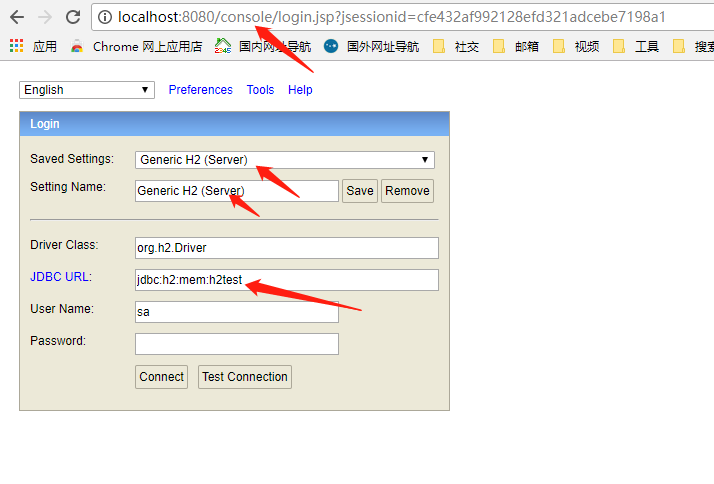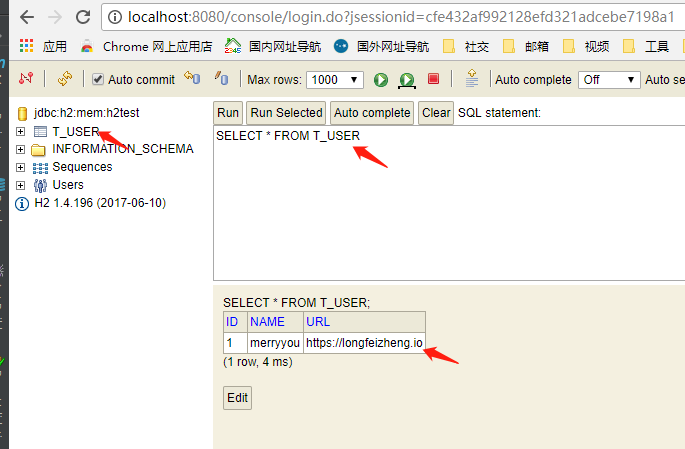H2 is an open source relational database implemented in pure java provided by Thomas Mueller.
Preface
This article guides you to integrate H2 memory databases using Spring Boot, Spring Data JPA. For more information on H2 data: http://www.h2database.com/html/tutorial.html
Get ready
- JDK 1.8 or later
- Maven 3 or later
technology stack
- Spring Data JPA
- Spring Boot
directory structure
pom.xml
<?xml version="1.0" encoding="UTF-8"?> <project xmlns="http://maven.apache.org/POM/4.0.0" xmlns:xsi="http://www.w3.org/2001/XMLSchema-instance" xsi:schemaLocation="http://maven.apache.org/POM/4.0.0 http://maven.apache.org/xsd/maven-4.0.0.xsd"> <parent> <artifactId>jpa-example</artifactId> <groupId>cn.merryyou</groupId> <version>1.0-SNAPSHOT</version> </parent> <modelVersion>4.0.0</modelVersion> <artifactId>h2-webconsole</artifactId> <properties> <project.build.sourceEncoding>UTF-8</project.build.sourceEncoding> <java.version>1.8</java.version> </properties> <dependencies> <dependency> <groupId>org.springframework.boot</groupId> <artifactId>spring-boot-starter-data-jpa</artifactId> </dependency> <dependency> <groupId>com.h2database</groupId> <artifactId>h2</artifactId> <version>1.4.196</version> </dependency> <dependency> <groupId>org.projectlombok</groupId> <artifactId>lombok</artifactId> </dependency> <dependency> <groupId>org.springframework.boot</groupId> <artifactId>spring-boot-starter-test</artifactId> <scope>test</scope> </dependency> <dependency> <groupId>org.springframework.boot</groupId> <artifactId>spring-boot-starter-web</artifactId> </dependency> </dependencies> <build> <plugins> <plugin> <groupId>org.springframework.boot</groupId> <artifactId>spring-boot-maven-plugin</artifactId> </plugin> <plugin> <groupId>org.apache.maven.plugins</groupId> <artifactId>maven-compiler-plugin</artifactId> <version>3.6.1</version> <configuration> <source>1.8</source> <target>1.8</target> </configuration> </plugin> </plugins> </build> </project>
Entity class
User
@Entity @Table(name = "t_user") @Data public class User { @Id @GeneratedValue(strategy = GenerationType.IDENTITY) private Long id; private String name; private String url; @Override public String toString() { return "User{" + "id=" + id + ", name='" + name + '\'' + ", url='" + url + '\'' + '}'; } }
-
The @Table declares that this object maps to the database's data tables by which the names of tables (talbe), catalogs, and schema s can be specified for entities. This annotation is not required, and if not, the system uses the default value (the short class name of the entity).
-
Id declares this property as the primary key. This attribute value can be created by itself, but Hibernate recommends that it be generated by Hibernate
-
GeneratedValue specifies the primary key generation strategy.
- TABLE: Save id values with tables
- IDENTITY: identitycolumn
- SEQUENCR : sequence
- AUTO: The three above are used differently depending on the database.
-
Column declares the mapping relationship between the attribute and the database field.
AddressRepository
public interface UserRepository extends JpaRepository<User, Integer> { }
Spring Data JPA includes some built-in Repository and implements some commonly used methods: findone, findall, save, etc.
application.yml
spring: datasource: url: jdbc:h2:mem:h2test;DB_CLOSE_DELAY=-1;DB_CLOSE_ON_EXIT=FALSE platform: h2 username: sa password: driverClassName: org.h2.Driver jpa: database-platform: org.hibernate.dialect.H2Dialect hibernate: ddl-auto: update properties: hibernate: show_sql: true use_sql_comments: true format_sql: true h2: console: enabled: true path: /console settings: trace: false web-allow-others: false logging: level: debug
Connection configuration
Configuration of database connection in application.yml file
- spring.datasource.url=jdbc:h2:mem:h2test, configure the connection address of H2 database
- spring.datasource.driver-class-name=org.h2.Driver, configure JDBC Driver
- spring.datasource.username=sa, configure database username
- spring.datasource.password=, configure database password
When you complete the two steps of dependency and connection configuration, you can use h2 in the program type. spring will automatically help you complete the injection of DataSource.
Data initialization configuration
If you need to initialize the database at program startup, configure the database access in the application.properties file
- spring.datasource.schema=classpath:db/schema.sql. After this configuration, every time the program is started, the program runs the resources/db/schema.sql file to operate on the structure of the database.
- spring.datasource.data=classpath:db/data.sql. After this configuration, every time the program starts, the program runs the resources/db/data.sql file to operate on the database.
This configuration is very suitable for the development environment. I will put the database structure SQL in resources/db/schema.sql and the data SQL in resources/db/data.sql. So every time I run the program, I get a new database. This eliminates the need for me to modify the data every time for testing.
h2 web consloe configuration
h2 web consloe is a database GUI management application similar to phpMyAdmin. When the program runs, h2 web consloe is automatically started. Of course, you can also configure it as follows.
- spring.h2.console.settings.web-allow-others=true. With this configuration, h2 web consloe can be accessed remotely. Otherwise, it can only be accessed locally.
- spring.h2.console.path=/h2-console. With this configuration, you can access h2 web consloe through YOUR_URL/h2-console. YOUR_URL is the access URl of your program.
- spring.h2.console.enabled=true. With this configuration, the h2 web consloe will start when the program starts. This is the default, of course. If you don't want to start h2 web consloe at startup time, set it to false.
UserRepositoryTest
@SpringBootTest @RunWith(SpringRunner.class) @Slf4j public class UserRepositoryTest { @Autowired private UserRepository userRepository; @Test public void saveTest() throws Exception { User user = new User(); user.setName("Zheng Long Fei"); user.setUrl("http://merryyou.cn"); User result = userRepository.save(user); log.info(result.toString()); Assert.assertNotNull(user.getId()); } @Test public void findOneTest() throws Exception{ User user = userRepository.findOne(1l); log.info(user.toString()); Assert.assertNotNull(user); Assert.assertTrue(1l==user.getId()); } }
h2 web consloe
Code download
Download it from my github. https://github.com/longfeizheng/jpa-example/tree/master/h2-webconsole
(viii) Focus on the course of java architects for Wechat applets Are you bored on the way to and from work? Are you still reading novels and news? Don't you know how to improve your skills? Come on, here's the Java architecture article you need. The 1.5w + java engineers are looking at it. What are you waiting for?



